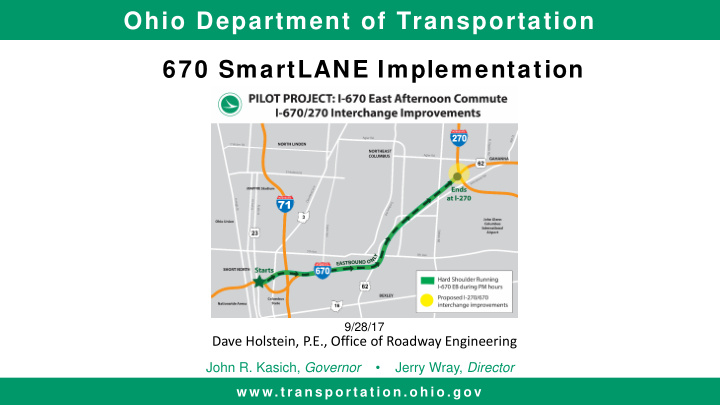



Ohio Department of Transportation 670 SmartLANE Implementation 9/28/17 Dave Holstein, P.E., Office of Roadway Engineering John R. Kasich, Governor • Jerry Wray, Director w w w. t r a n s p o r t a t i o n . o h i o . g o v
How We Got to HSR ODOT Conducted State Wide ATDM Study of All Freeway Corridors: 2
How We Got to HSR ATDM Strategies Considered for Each Corridor: • Ramp Metering • Hard Shoulder Running (HSR)– Busses Only • Hard Shoulder Running (HSR) – Mixed Traffic • Dynamic Merge Control • Variable Speed Limits/Speed Harmonization • Choice Lanes • HOV Lanes • HOT Lanes • Dynamic Lane Assignment • Contra-flow Lanes 3
Cincinnati Columbus Potential Hard Shoulder Running Winner!! Corridors Boiled Down ATDM Study Into I-670 EB 4 Possible HSR Pilot Locations: Chose HSR Pilot on I-670 (EB ONLY) Due to it’s Physical Attributes and Concentrated Hours of Congestion 4
May-October 2015 (Tues-Thurs), Average Speed of All Lanes 5-6PM HSR Traditional Projects Underway Acute Congestion – Only 2 Hours Per Day 5
Interchange Weave Needs Fixed for I-670 EB HSR to Work Best HSR 6
Hard Shoulder Running 9 full matrix signs – Variable Speed Limits – Controlled by TMC 7
Hard Shoulder Running Geometrics & Considerations 12’ 12’ 4’ 12’ 11.5’ 10’ Lane/Shoulder New Typical Section • Reduced Outside Shoulder from 12’ to 10’ in places. Shifted ex. lanes out; Smart • Resurfacing to provide new lane location striping (no grinding of markings); • Resurfacing to relocate pavement crown to accommodate lane shift; Checks/Challenges • Super elevation correction putting traffic on former inside shoulder; • Truck tracking of narrower lane; • Drainage/hydraulic spread on reduced shoulder area (we added 16 inlets); • How is best way to get OUT of the HSR lane!!!!! (more on that later); • Gantry Placement – cohabitation with existing signs 8
Cost Costs: $52M • $35M – Interchange Weave (Separate but related problem that needed fixed) • $3.5M – Bridges (Unrelated to HSR – Coincidentally Needed Maintenance Work) • $11M – ITS HSR Specific Costs • $2.5M – Resurfacing/Drainage Total = $52M Cost to provide traditional widening for extra lane + shoulder at least $25M additional compared to the HSR option (R/W, Structures, Interchanges). 9
Benefits • “Extra” capacity only when needed (4-6P). WsDOT Crash Experience on US-2 HSR Other 22 hours retain use of shoulder; • Travel time reduction of 33%-45% • Avoids impacts to neighborhoods and interchanges; • Faster project delivery than widening ATDM 2016 Sale 2018 Design & PI 2017 End Construction 2019 10
HSR Lane – Termination 11
Smart lane/Shoulder New Perm. Lane Existing Lane New Perm. Lane Smart Lane/Ex. Shoulder
Public Involvement • Targeted Outreach & Feedback • Law Enforcement, Local Govt., ODOT Operations 1 • NEPA Public Involvement • Public Education on Concept 2 • Construction Outreach – MOT & Continuing Reinforcement after Opening Day 3 13
Operations System Startup Variable Speed Limit Maintenance Inclement Weather Law Enforcement Incident Management 14
System Startup Daily Sweep Prior to Opening – Visual & Physical 15
Variable Speed Limit 16
Maintenance & Inclement Weather Shoulder will be treated as a lane. Plow/brine frequency will be increased Snow storage may require closure of shoulder until gang plowing can move it Signs have rear catwalk access. 17
Law Enforcement Speed limit changes will be logged Maintaining the right shoulder will be important for enforcement, incident access Ongoing discussion with CPD, Columbus Prosecutor 18
Incident Management A dedicated operator will have information collected by the CCTV and other sensors, and will work with Law Enforcement to open/close lanes and slow traffic in advance of an incident. 19
Questions? Dave Holstein Dave.Holstein@dot.state.oh.us 614.644.8137 20
Recommend
More recommend